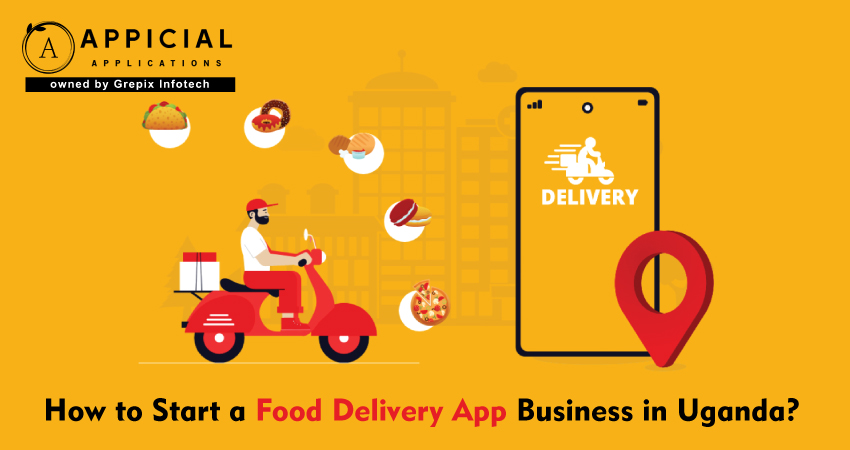
How to Start a Food Delivery App Business in Uganda?
Let’s face it!
Let’s be real, most of us in Uganda love good food, but hate the hustle of getting it. Whether it’s lunch at the office in Kampala or a late-night snack in Mbarara, having food delivered right to your doorstep. That’s the convenience people are willing to pay for.
Now think about this: what if you were the person building the next big food delivery app in Uganda? An app that connects local food vendors, restaurants, and boda riders to customers across town? That’s not just a business, that’s a digital movement waiting to happen.
And guess what? To get started, you don't have to be a tech expert or a millionaire. To make it a reality, all you need is a good plan, an original idea, and a reliable tech partner like Appicial Applications.
This guide is the first step if you've been dreaming of creating a delivery app that genuinely benefits your community. Let's make that concept a reality.
This guide takes you through everything you need to know to get started in plain, simple language. We cover the reasons why the Ugandan market is ripe for disruption, the essential features your app must include to keep users happy, and the tech tools you’ll need behind the scenes to make it all run smoothly.But we don’t stop at the tech. We also explore the real-world challenges unique to Uganda, from tricky street navigation to network issues, and show you how to overcome them with smart design and local understanding. We even break down the development costs, so you know exactly what to expect based on your budget.And the best part? You don’t have to figure it out alone. With Appicial Applications as your development partner, you’ll have access to a team that knows this space inside out. They will help you move quickly, stay lean, and launch with confidence, from developing your MVP to scaling your app across cities.
Why Invest in Food Delivery App Development in Uganda?
Before we talk features or budgets, let’s address the why. Why should someone like you even think of launching a food delivery app in Uganda?
a) The Lifestyle Shift is Real
In places like Entebbe, Mukono, and Kampala, people are getting busier. They are juggling work, side projects, and family obligations because they don't have much time. Cooking? Going to pick food during heavy rain or traffic? Not ideal. That’s where delivery apps step in.
b) Smartphones Are Everywhere
Uganda’s smartphone penetration is growing fast. From university students to boda boda riders, almost everyone owns a smartphone and they’re not just for TikTok and WhatsApp. People are learning to order, shop, and pay online.
c) Mobile Money is Already Part of Our Daily Life
If your app integrates with MTN MoMo or Airtel Money, you’ve already solved one of the biggest global challenges, getting people to trust digital payments. Ugandans trust mobile money more than debit cards, and that’s a huge advantage.
d) The Market Isn’t Crowded Yet
Sure, you have players like Jumia Food and Glovo in Kampala, but what about Fort Portal? Mbale? Gulu? There are still so many places without reliable food ordering apps. You could be the first mover in your city.
e) Local Food, Local Taste
A food delivery app built for Uganda should reflect Ugandan eating habits. Chapati and beans, katogo, rolex, TV chicken, people want these delivered too, not just burgers and pizza. That’s your edge.
What are the Must-Have Features for a Food Delivery App?
Here’s what your app needs to nail:
For Customers
- Quick Signup: Phone number, email, or social login.
- Restaurant Listings: With location filters, ratings, and opening hours.
- Menu with Images: Food is visual. Let users see what they’re ordering.
- Real-Time Order Tracking: Let them follow their order from the kitchen to the doorstep.
- Payment Options: MTN MoMo, Airtel Money, cards (if needed).
- Order History & Reordering: Make life easier for regulars.
- Push Notifications: For deals, delivery updates, and delays.
For Restaurants
- Easy Menu Management: Add/edit items, pricing, images.
- Order Management: Accept or reject orders in real-time.
- Daily Sales Dashboard: For tracking orders and revenue.
- Customer Feedback Panel: Know what customers are loving (or not).
For Delivery Riders
- Rider App with Route Guidance: Show nearby deliveries and optimal routes.
- Earnings Dashboard: Transparency builds loyalty.
- Availability Toggle: When they’re ready to hustle, let them go online.
Admin Dashboard
- Restaurant & Rider Management
- Commission Settings
- Analytics & Reports
- Promo Code Setup
- Customer Service Panel
That’s your full doordash delivery app blueprint, but made for Uganda.
Technology Stack and Architecture
Frontend (what users see)
Flutter or React Native, great for Android and iOS apps.
Backend (what powers the app)
Node.js or Python; secure and scalable.
Database
MongoDB or PostgreSQL to store orders, menus, and user data.
Push Notifications
Firebase for real-time order alerts.
Map & Location Services
Google Maps or OpenStreetMap for tracking drivers.
Payment Integration
MTN MoMo API, Airtel Money, and Flutterwave for easy local payments.
Hosting
AWS or Google Cloud for fast, global performance.
This setup gives you a smooth, fast, and stable app, just like Grubhub delivery or DoorDash food delivery platforms, but optimized for Uganda.
What are the Challenges and Market Gaps in Uganda?
Let’s be honest, launching a startup isn’t all sunshine and rolex. Here are a few real-world hurdles:
a) Addresses Can Be… Complicated
In Uganda, house numbers and street names don’t always make sense. Use GPS pins and give customers the option to add landmarks like “next to the boda stage.”
b) Kampala Traffic = Delays
Riders must know the shortcuts. You can even offer incentives for on-time deliveries.
c) Not All Vendors are Tech-Savvy
You’ll need to provide simple onboarding, maybe even in-person training, especially for local food vendors.
d) Weather is a Big Factor
Heavy rain means late deliveries. Let customers know delays are weather-related, build trust with transparency.
e) Cost Sensitivity
Low delivery costs for consumers, healthy restaurant profit margins, and equitable rider compensation must all be balanced in your app.
Also Read: How to Start a Food Delivery App Business in Tanzania
What is the Estimated Development Cost & Timeline?
You’re probably wondering, What’s this going to cost me?
Let’s break it down:
MVP (Minimum Viable Product)
- Basic app for customers, riders, and restaurants
- Admin dashboard
- Mobile money integration
- Timeline: 4 to 6 weeks
- Estimated Cost: $7,000 to $10,000
Full-Featured App
- Advanced design
- Loyalty programs
- Real-time analytics
- Promo codes & customer wallet
- Timeline: 8 to 12 weeks
- Estimated Cost: $15,000 to $30,000
Remember: starting small is smart. You can always add more features as you grow.
How Appicial Applications Can Help?
You don’t need to build this alone. Appicial Applications is your perfect tech partner.
Here’s what we bring to the table:
Ready-to-Launch Solutions
Want a DoorDash food delivery clone but made for Uganda? We’ve got it. Fully customizable, branded for you, and ready to launch.
Local Expertise
We’ve worked with businesses across Africa. We get the tech and the culture.
Fast Development
You can launch your MVP in under a month. We don’t waste your time.
Affordable Pricing
We keep the food delivery app development cost transparent and reasonable.
Lifetime Support
Once your app is live, we don’t disappear. We stick with you to help it grow.
Conclusion
Uganda is ready for more food delivery apps. People want fast, affordable, and reliable food service, and most cities still don’t have enough options.
That gap? That’s your business opportunity.
Whether you want to build a local food ordering empire in Kampala, serve home-cooked meals in Jinja, or bring chapati delivery to Gulu, the market is open, and the timing is right.
And with Appicial Applications by your side, you’ll get the tech, support, and strategy you need to launch a successful food delivery app business, without breaking the bank or losing your mind.
Ready to build your food delivery dream? Partner with Appicial Applications, your trusted expert in food delivery app development.
FAQs
Author's Bio

Vinay Jain is the Founder at Grepix Infotech and brings over 12 years of entrepreneurial experience. His focus revolves around software & business development and customer satisfaction.
Back to blog list




